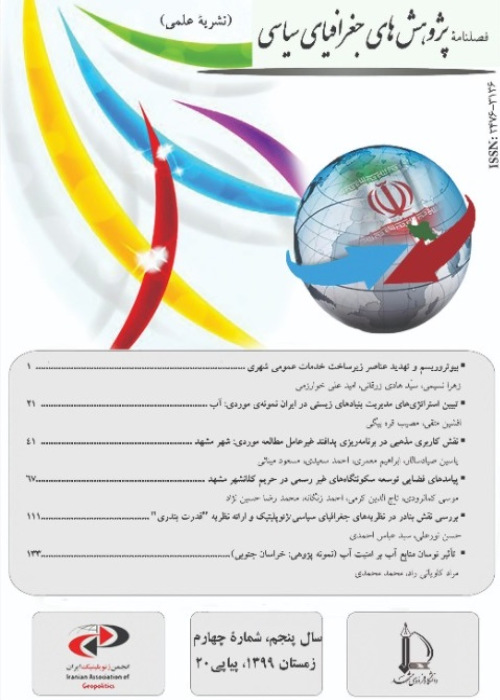Geopolitical Analysis of Yemen Crisis
Author(s):
Article Type:
Research/Original Article (دارای رتبه معتبر)
Abstract:
IntroductionYemen is an ancient country with long history which is involved in many turbulences and crises such as wars with the Romans, Ethiopians, Iranian, Ottoman Turks, Portuguese, Britons, Egyptians, Saudis, etc. Especially in the twentieth century, the country has experienced many political developments, such as various wars, independence, splitting into two countries, unity, civil wars and so on that their effects are still ongoing. The present study seeks to analyze the country's recent crisis from political geography and geopolitical point of view. The geography of Yemen particularly in physical, human, economic, political, and strategic dimensions, provides facilities as well as a context for domestic and foreign interventionist forces to act, influence, and intervene. Although the main starting point of the recent crisis in Yemen were domestic issues, considering the physical, human, and strategic characteristics of the country's geography, quickly became widespread with the involvement of regional and trans-regional actors. First the method of analysis of the study is to investigate the main and important geographical effective factors in the crisis. Then, how the competing forces benefit these factors at various national, regional, and transnational levels is considered.
MethodologyThe research method is descriptive-analytic. Data is collected in a library method and using internet resources. The analysis has been carried out mainly qualitatively.
Results and DiscussionCreating a different lifestyle, physical geography factors, such as topography and climate, are the underlying factors for human diversities. In Yemen, physical geography factors, indirectly and through the orientation of human diversity, play a crucial role in the political and social crises, and directly provide facilities for the playing forces in the country. These factors play a significant role in the survival and power strengthening of different human groups, especially Zaydis.
Yemen's human geography factors such as religion have also led to the creation and continuation of the crisis in the country. In addition, the largely tribal social system of the country plays a decisive role in the developments. There are about 700 small or large tribes in Yemen, which more than 400 of them are Zaydis living in mountainous areas of the northern parts of the country that geography plays an important role in their survival.
The role of economic geography factors in Yemen crisis is mainly due to the distribution of economic resources, the transfer of resources, the dominant economic activity, the unbalanced distribution of wealth and facilities, and in general the geography of poverty and wealth. The crisis like a defective cycle causes economic deterioration and bankruptcy and a continuation of poverty and crisis cycle, such as the country's oil production that decreased from 429,000 barrels per day in 2003 to about 47,000 barrels in 2015.
The effective political geography factors in Yemen crisis have a wide range that has played a role from ancient times to the present. The ancient history of the country has caused many incidents such as wars between this country and other countries. The process of independence and unity has accompanied various volatility and events, and this country has been caught up in the dominant powers before and after its independence, and has experienced different political events and even civil wars, and now their effects can be seen as de facto division of the country mainly based on the pre-unified parts.
The activities of Salafi extremists and Al-Qaeda in Yemen lead to the complexity of the country's crisis and foreign intervention. The strategic geography factors affecting Yemen crisis are mainly based on the geographical situation of both the country itself and the situation of human groups residing in the strategic areas of the country. The country's position along the strait of Bab-el-Mandeb also encourages the involved parties to take control of the strait, and that is not something that regional and trans-regional powers want to easily ignore. Yemen territorial and border disputes, especially with Saudi Arabia, which have a historical background, have remained unresolved in the minds of Yemen people, despite the measures taken to resolve it in 2000.
ConclusionDue to the comprehensive view of geography, analyzing issues with geographic and geopolitical perspectives leads to a precise rooting of the causes of them. Yemen is a country that has been in crisis and unrest over a long period of time; the latest round of crisis has come after the Middle East upraises called the Arab Spring. Despite the success of the overthrow of the head of state, the problems and insecurities of the country have increased. The competition of domestic forces has led to the division of the country into two de facto northern and southern parts of the north and south as before the unification in 1990. The intervention of regional and trans-regional forces in this crisis turned it from national into a transnational crisis, with no clear prospect for solving.
The analysis of the recent crisis of Yemen from the geopolitical point of view shows that physical, human, economic, political, strategic, and other geographic factors are the basis of the country's crises, and the rival forces involved in different internal, regional and trans-regional levels are using these geographic basis and trying to expand their position in the transformation. The characteristics of geographic factors are rooted and highly stable leading to the stability of the crises, and it is very difficult to solve them. Therefore, the crisis is persistent and chronic in Yemen because of the effects of geographic and relatively stable factors.
MethodologyThe research method is descriptive-analytic. Data is collected in a library method and using internet resources. The analysis has been carried out mainly qualitatively.
Results and DiscussionCreating a different lifestyle, physical geography factors, such as topography and climate, are the underlying factors for human diversities. In Yemen, physical geography factors, indirectly and through the orientation of human diversity, play a crucial role in the political and social crises, and directly provide facilities for the playing forces in the country. These factors play a significant role in the survival and power strengthening of different human groups, especially Zaydis.
Yemen's human geography factors such as religion have also led to the creation and continuation of the crisis in the country. In addition, the largely tribal social system of the country plays a decisive role in the developments. There are about 700 small or large tribes in Yemen, which more than 400 of them are Zaydis living in mountainous areas of the northern parts of the country that geography plays an important role in their survival.
The role of economic geography factors in Yemen crisis is mainly due to the distribution of economic resources, the transfer of resources, the dominant economic activity, the unbalanced distribution of wealth and facilities, and in general the geography of poverty and wealth. The crisis like a defective cycle causes economic deterioration and bankruptcy and a continuation of poverty and crisis cycle, such as the country's oil production that decreased from 429,000 barrels per day in 2003 to about 47,000 barrels in 2015.
The effective political geography factors in Yemen crisis have a wide range that has played a role from ancient times to the present. The ancient history of the country has caused many incidents such as wars between this country and other countries. The process of independence and unity has accompanied various volatility and events, and this country has been caught up in the dominant powers before and after its independence, and has experienced different political events and even civil wars, and now their effects can be seen as de facto division of the country mainly based on the pre-unified parts.
The activities of Salafi extremists and Al-Qaeda in Yemen lead to the complexity of the country's crisis and foreign intervention. The strategic geography factors affecting Yemen crisis are mainly based on the geographical situation of both the country itself and the situation of human groups residing in the strategic areas of the country. The country's position along the strait of Bab-el-Mandeb also encourages the involved parties to take control of the strait, and that is not something that regional and trans-regional powers want to easily ignore. Yemen territorial and border disputes, especially with Saudi Arabia, which have a historical background, have remained unresolved in the minds of Yemen people, despite the measures taken to resolve it in 2000.
ConclusionDue to the comprehensive view of geography, analyzing issues with geographic and geopolitical perspectives leads to a precise rooting of the causes of them. Yemen is a country that has been in crisis and unrest over a long period of time; the latest round of crisis has come after the Middle East upraises called the Arab Spring. Despite the success of the overthrow of the head of state, the problems and insecurities of the country have increased. The competition of domestic forces has led to the division of the country into two de facto northern and southern parts of the north and south as before the unification in 1990. The intervention of regional and trans-regional forces in this crisis turned it from national into a transnational crisis, with no clear prospect for solving.
The analysis of the recent crisis of Yemen from the geopolitical point of view shows that physical, human, economic, political, strategic, and other geographic factors are the basis of the country's crises, and the rival forces involved in different internal, regional and trans-regional levels are using these geographic basis and trying to expand their position in the transformation. The characteristics of geographic factors are rooted and highly stable leading to the stability of the crises, and it is very difficult to solve them. Therefore, the crisis is persistent and chronic in Yemen because of the effects of geographic and relatively stable factors.
Keywords:
Language:
Persian
Published:
Research Political Geography, Volume:2 Issue: 1, 2017
Pages:
165 to 193
magiran.com/p1833864
دانلود و مطالعه متن این مقاله با یکی از روشهای زیر امکان پذیر است:
اشتراک شخصی
با عضویت و پرداخت آنلاین حق اشتراک یکساله به مبلغ 1,390,000ريال میتوانید 70 عنوان مطلب دانلود کنید!
اشتراک سازمانی
به کتابخانه دانشگاه یا محل کار خود پیشنهاد کنید تا اشتراک سازمانی این پایگاه را برای دسترسی نامحدود همه کاربران به متن مطالب تهیه نمایند!
توجه!
- حق عضویت دریافتی صرف حمایت از نشریات عضو و نگهداری، تکمیل و توسعه مگیران میشود.
- پرداخت حق اشتراک و دانلود مقالات اجازه بازنشر آن در سایر رسانههای چاپی و دیجیتال را به کاربر نمیدهد.
In order to view content subscription is required
Personal subscription
Subscribe magiran.com for 70 € euros via PayPal and download 70 articles during a year.
Organization subscription
Please contact us to subscribe your university or library for unlimited access!



